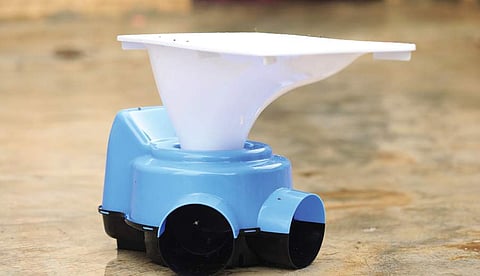

Until a few months ago, 40-year-old Krishnaveni B, a mother of four had never seen or used a toilet before. Everyday, be it during the day or the middle of the night, she would have to walk a few kilometres from her house and go into the forests to relieve herself. Her main fear though was for her young daughters. She feared for their safety every time they went out.
This was a common story for most households in Kannanur, Tiruchy. With hardly any toilets in the area, open defecation was a common practice here. Not only was this extremely inconvenient, it also brought with it the threat of numerous diseases such as jaundice and typhoid.
Today, however, things have taken a big turn in this town. People like Krishnaveni no longer have to walk miles to relieve themselves. SATO, an initiative by Japanese company LIXIL, recently constructed 14 bio-toilets in households in the area. With its unique features, mainly the automatic flap door, SATO toilets ensure that flies and insects are kept away and people get to live in more hygienic conditions.
Why do many people resort to open defecation?
As part of the government's Swachh Bharat initiative, there were crores of toilets constructed across the country. However, people were still facing a number of challenges that didn't allow them to use toilets effectively, such as the intense water shortage in many parts of India. Groundwater, which accounts for 40 per cent of the country's water supply is steadily depleting and other sources are running dry too. As a lot of water is required to flush the excreta down, proper sanitation becomes difficult inspite of the facilities in place and people in rural areas resort to open defecation instead. Another major cause is the smell. Normal toilets have a stench long after use and a lot of rural residents prefer to defecate in the open rather than in their homes to avoid the smell. Also, the cost factor played a major role. Normal toilets could be quite expensive to construct and the subsidies provided by the government, although helpful, was only given as reimbursements.
SATO's design helps solve a number of the above challenges. "Firstly, it is cost-effective and easy to construct. The toilet has a blue plastic toilet pan placed directly over a single pit. It has an automatically-closing trap door that blocks odour and insects. All you need to flush down the excreta is about 0.2 to 1 litre of water (1 mug). The trap door instantly opens and shut itself tightly after use. Thus, water shortage doesn't really impact the use of it," says Dhananjay Singh, Head, SATO India. SATO toilets were launched in India in 2017 and their products have been sold across 14 countries worldwide including Bangladesh, Phillipines, Kenya, Uganda and Haiti.
These toilets are made out of virgin polypropylene, which is comparatively cheaper than ceramic, the material that is otherwise used for toilets. "The trap door prevents insects from contacting waste and thus prevents diseases caused by them. It also eliminates any odour, thereby making it more comfortable for people to use it," Dhananjay adds.
Employment opportunities
SATO pan toilets are locally produced, thereby, bringing down the costs incurred, and also providing employment opportunities to the locals, especially women. "Around 13,000 masons are trained across the country. Each of them receive about Rs 500 a day," says Dhananjay.
In the pits
Before SATO toilets were installed, traditional toilets in rural areas had two pipes that were connected to two separate pits. The waste would drain into one pit till it fills up, after which a mason would have to adjust the toilet so that the waste drains into the second pit. In order to do this, the ceramic toilet had to be reopened, the first pipe sealed shut and the second pipe's seal opened. It was an intensive and messy process.
With SATO pan toilets, that's another challenge that is quite easily resolved. SATO's V-trap toilets remove the hassle of switching between the pits. The toilet connects to two plastic pipes. After the first pit fills up, any long stick-like object can be used to switch to the second pipe. There's no mess and no reconstruction required.
